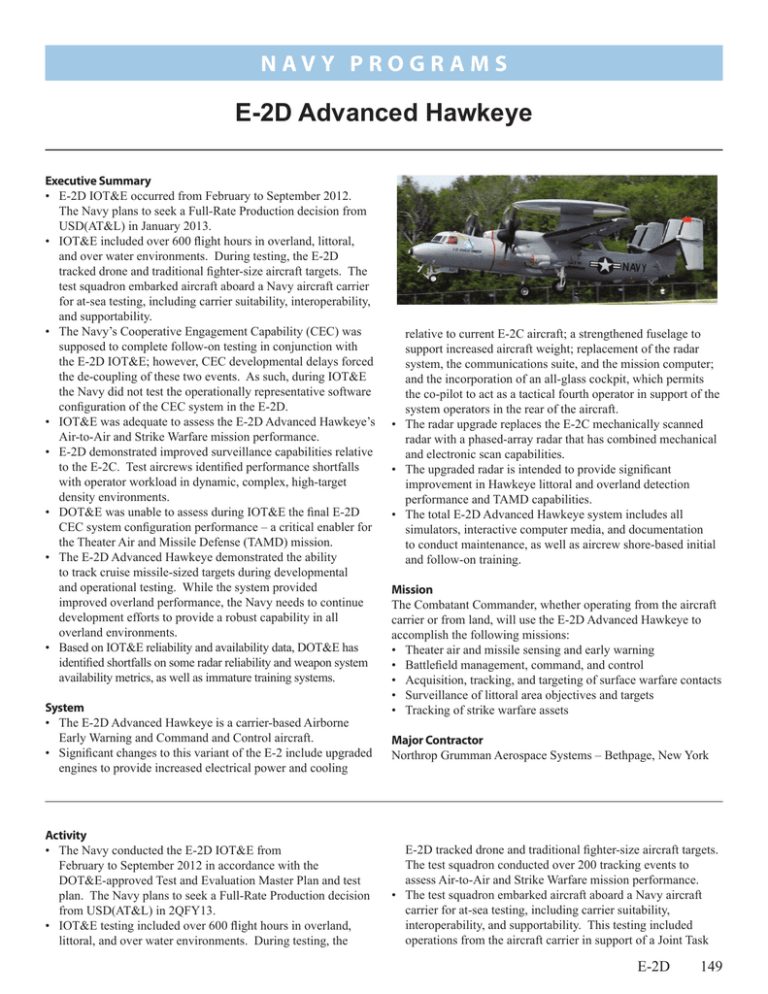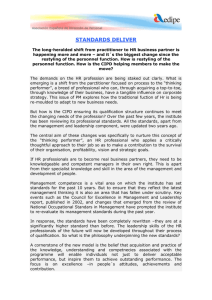N a v y P R O G...
advertisement

N av y P R O G R A M S E-2D Advanced Hawkeye Executive Summary • E-2D IOT&E occurred from February to September 2012. The Navy plans to seek a Full-Rate Production decision from USD(AT&L) in January 2013. • IOT&E included over 600 flight hours in overland, littoral, and over water environments. During testing, the E-2D tracked drone and traditional fighter-size aircraft targets. The test squadron embarked aircraft aboard a Navy aircraft carrier for at-sea testing, including carrier suitability, interoperability, and supportability. • The Navy’s Cooperative Engagement Capability (CEC) was supposed to complete follow-on testing in conjunction with the E-2D IOT&E; however, CEC developmental delays forced the de-coupling of these two events. As such, during IOT&E the Navy did not test the operationally representative software configuration of the CEC system in the E-2D. • IOT&E was adequate to assess the E-2D Advanced Hawkeye’s Air-to-Air and Strike Warfare mission performance. • E-2D demonstrated improved surveillance capabilities relative to the E-2C. Test aircrews identified performance shortfalls with operator workload in dynamic, complex, high-target density environments. • DOT&E was unable to assess during IOT&E the final E-2D CEC system configuration performance – a critical enabler for the Theater Air and Missile Defense (TAMD) mission. • The E-2D Advanced Hawkeye demonstrated the ability to track cruise missile-sized targets during developmental and operational testing. While the system provided improved overland performance, the Navy needs to continue development efforts to provide a robust capability in all overland environments. • Based on IOT&E reliability and availability data, DOT&E has identified shortfalls on some radar reliability and weapon system availability metrics, as well as immature training systems. System • The E-2D Advanced Hawkeye is a carrier-based Airborne Early Warning and Command and Control aircraft. • Significant changes to this variant of the E-2 include upgraded engines to provide increased electrical power and cooling Activity • The Navy conducted the E-2D IOT&E from February to September 2012 in accordance with the DOT&E‑approved Test and Evaluation Master Plan and test plan. The Navy plans to seek a Full-Rate Production decision from USD(AT&L) in 2QFY13. • IOT&E testing included over 600 flight hours in overland, littoral, and over water environments. During testing, the relative to current E-2C aircraft; a strengthened fuselage to support increased aircraft weight; replacement of the radar system, the communications suite, and the mission computer; and the incorporation of an all-glass cockpit, which permits the co-pilot to act as a tactical fourth operator in support of the system operators in the rear of the aircraft. • The radar upgrade replaces the E-2C mechanically scanned radar with a phased-array radar that has combined mechanical and electronic scan capabilities. • The upgraded radar is intended to provide significant improvement in Hawkeye littoral and overland detection performance and TAMD capabilities. • The total E-2D Advanced Hawkeye system includes all simulators, interactive computer media, and documentation to conduct maintenance, as well as aircrew shore-based initial and follow-on training. Mission The Combatant Commander, whether operating from the aircraft carrier or from land, will use the E-2D Advanced Hawkeye to accomplish the following missions: • Theater air and missile sensing and early warning • Battlefield management, command, and control • Acquisition, tracking, and targeting of surface warfare contacts • Surveillance of littoral area objectives and targets • Tracking of strike warfare assets Major Contractor Northrop Grumman Aerospace Systems – Bethpage, New York E-2D tracked drone and traditional fighter-size aircraft targets. The test squadron conducted over 200 tracking events to assess Air-to-Air and Strike Warfare mission performance. • The test squadron embarked aircraft aboard a Navy aircraft carrier for at-sea testing, including carrier suitability, interoperability, and supportability. This testing included operations from the aircraft carrier in support of a Joint Task E-2D 149 N av y P R O G R A M S Force-level exercise as well as additional interoperability testing during Carrier Strike Group certification training, which involved all current carrier air wing capable aircraft. The test squadron conducted E-2D operations while participating in joint Large Force Exercises at Nellis AFB, Nevada, and Fallon Naval Air Station, Nevada. Additionally, the test squadron conducted over-water TAMD tracking exercises operating with Navy ships off the California coast. • The Navy’s CEC program planned to complete follow-on testing in conjunction with the E-2D IOT&E; however, CEC developmental delays forced the de-coupling of these two events. As such, during IOT&E the Navy did not test the operationally representative software configuration of the CEC system in the E-2D. The Navy addressed the flaws in the CEC system during the summer of 2012 with new system software loads for both the E-2D mission system and the CEC system and entered follow-on test for the CEC system in October 2012. Assessment • IOT&E was adequate to assess the E-2D Advanced Hawkeye’s legacy mission performance. DOT&E expects to publish a report assessing the E-2D IOT&E performance in January 2013. • E-2D was found to have improved surveillance capabilities relative to the E-2C. Test aircrews identified performance shortfalls with operator workload in dynamic, high‑target density environments where the E-2D mission system erroneously swapped identification labels for crossing / closely‑spaced aircraft tracks. Subsequently, the tracks required manual aircrew re-labeling in the mission system, which can lead to operator overload and loss of situational awareness. • DOT&E was unable to assess the final E-2D CEC system configuration performance – a critical enabler for the TAMD mission. The TAMD mission, which is the primary reason the E-2D is being procured, will not be fully accessible until the CEC system is successfully tested and end-to-end TAMD testing is completed in the 2015 timeframe, shortly before the E-2D Initial Operational Capability declaration. • The E-2D Advanced Hawkeye demonstrated the ability to track cruise missile-sized targets during developmental and operational testing. While the system provided improved overland performance, the Navy needs to continue radar and mission system development efforts to provide a robust capability in all overland environments. • With the exception of CEC testing still in progress, E-2D voice and datalink communications match those of E-2C. The E-2D has the same Passive Detection System found in the E-2C. DOT&E assesses this capability as matching that of the current E-2C. • The E-2D mission planning system, the Joint Mission Planning System (JMPS), is not currently effective. Operators use the JMPS to provide a means of importing mission-planning data into the E-2D mission computer for use during flight. 150 E-2D There are JMPS shortcomings in reliability and usability causing the mission-planning process to be cumbersome and time‑consuming. Additionally, there is a deficiency with JMPS loading the proper network configuration data for some Link 16 networks. • Based on IOT&E reliability and availability data, DOT&E has identified shortfalls on some radar reliability and weapon system availability metrics. E-2D maintainability had no significant shortfalls in on-aircraft maintenance procedures, documentation, or support equipment. However, the maintenance training system for the E-2D will not be available until July 2013 due to prior acquisition decisions. The lack of a maintenance training system precludes a full assessment of the maintainability of the E-2D system. • DOT&E could not assess aircrew training due to the non‑availability of the E-2D integrated simulator, which will be used for shore-based initial and follow-on training, as well as aircrew tactical and carrier operating procedures proficiency. • The E-2D aircraft performed nominally during at-sea operations. The current E-2C system operates in a four aircraft-per-squadron configuration as opposed to the E-2D, which the Navy plans to operate in a five aircraft-per-squadron configuration. The E-2D at-sea testing did not demonstrate fully the ability to logistically support the proposed five-aircraft E-2D squadron in the aircraft carrier environment. The limited number of at-sea sorties and the current limited spare parts support for E-2D precluded a full at-sea logistics supportability assessment of the five-aircraft E-2D squadron concept. Recommendations • Status of Previous Recommendations. The Navy continues efforts to address CEC and radar performance improvements as recommended in FY11. These efforts are critical to achieving the 2015 E-2D Initial Operational Capability and full TAMD capability. • FY12 Recommendations. 1. The Navy should continue to improve E-2D CEC performance following completion of the E-2D CEC follow‑on test in January 2013. 2. The E-2D program should investigate potential radar and mission system performance upgrades to improve system performance in the challenging overland arena. 3. The E-2D program should resolve the mission system track re-labeling deficiency. 4. The E-2D program should work with the JMPS Program Office to provide for E-2D aircrews an effective mission planning system. 5. The E-2D program should aggressively focus on implementing the full logistics posture to support the E-2D five-aircraft squadron concept in the aircraft carrier environment. 6. The E-2D Program Office should continue to improve radar and overall weapon system reliability and availability.






